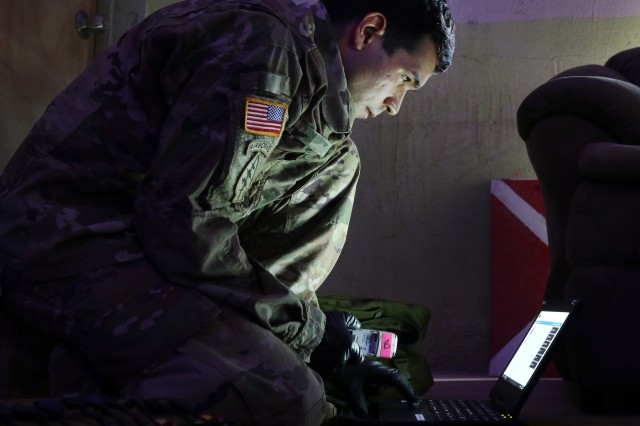Aug 12 2020
While operating a tactical communications network, one ever-increasing concerns is the potential detection of friendly transmissions by a well-equipped adversary.
 Army researchers develop an analysis framework that enables the rigorous study of the detectability of ultraviolet communication systems, providing the insights needed to deliver the requirements of future, more secure Army networks. Image Credit: K. Kassens.
Army researchers develop an analysis framework that enables the rigorous study of the detectability of ultraviolet communication systems, providing the insights needed to deliver the requirements of future, more secure Army networks. Image Credit: K. Kassens.
An analysis framework created by Army researchers now enables careful investigation of the detectability of ultraviolet communication systems, offering the understanding required to fulfill the requirements of future, more secure Army networks.
Specifically, the distinctive propagation characteristics offered by ultraviolet communication not just enable an innovative non-line-of-sight optical link but also indicate that the transmissions could be very difficult for an adversary to detect.
According to Dr Robert Drost of the U.S. Army Combat Capabilities Development Command’s Army Research Laboratory (CCDC ARL), the new framework—developed based on experimentally validated channel modeling, detection and estimation theory, and channel simulations—enables the assessment of tradeoffs related to various design choices and the operation mode of ultraviolet communication systems.
While many techniques have been proposed to decrease the detectability of conventional radio-frequency, or RF, communications, the increased atmospheric absorption of deep-ultraviolet wavelengths implies that ultraviolet communication, or UVC, has a natural low-probability-of-detection, or LPD, characteristic. In order to fully take advantage of this characteristic, a rigorous understanding of the LPD properties of UVC is needed.
Dr Robert Drost, Army Research Laboratory
Drost noted that such insights are specifically crucial for improving the design and operation of UVC systems and networks, as well as to estimate the quality of the LPD property for a specified scenario, for example, the use of UVC to securely network a command post that includes an estimate of the distance and direction to the adversary.
He added that the lack of such a predictive ability would lead to a lack of guidance for users to know the limit and extent of their detectability. Moreover, such a lack of awareness would considerably restrict the usefulness of the LPD capability.
This was demonstrated by the research team, including Drs Mike Weisman, Fikadu Dagefu, Terrence Moore, and Drost from CCDC ARL and Dr Hakan Arlsan, Oak Ridge Associated Universities postdoctoral fellow at the lab, by using the new framework to generate several key insights into the LPD characteristics of UVC, which includes:
- LPD capability is quite insensitive to several system and channel properties, which is crucial for the robustness of the LPD characteristic
- Line-of-sight UVC link offers non-line-of-sight standoff distances that correspond to the communication range
- Adversarial line-of-sight detection of a non-line-of-sight communication link is not such a crucial concern as one might consider
- In contrast to intuition, steering of a UVC transmitter does not seem to be a potent detection-mitigation approach in several cases
Previous modeling and experimental study has shown that UVC signals get drastically attenuated at long distance, thus resulting in the speculation that UVC hosts a basic LPD property, added Drost. But not much effort has gone in to precisely and meticulously measure this property in terms of the detectability of a communication signal.
Our work provides a framework enabling the study of the fundamental limits of detectability for an ultraviolet communication system meeting desired communication performance requirements.
Dr Robert Drost, Army Research Laboratory
Despite focusing on longer-term applications, he added, this study is addressing the Army Modernization Priority on Networks by gaining the basic insights into an innovative communications capability, with the aim to offer the Soldier the network connectivity, though the environments may be challenging and include adversarial activity.
“The future communications and networking challenges that the Army faces are immense, and it is essential that we explore all possible means to overcoming those challenges,” Drost explained.
Our research is ensuring that the community has the fundamental understanding of the potential for and limitations of using ultraviolet wavelengths for communications, and I am confident that this understanding will inform the development of future Army networking capabilities.
Dr Robert Drost, Army Research Laboratory
Conducting fundamental research that impacts decision making and Army technologies is why we work for the Army, and it is very satisfying to know that our work will ultimately support the warfighter in his or her mission,” added Drost.
At present, the researchers are continuing their efforts to gain a better understanding of the best ways to develop and operate ultraviolet communications. A crucial next step in this process is the use of this framework to gain insights into the detectability of a network of ultraviolet communications systems.
Another important attempt is the experimental description, investigation, and demonstration of this technology in a viable network with the help of ARL’s Common Sensor Radio, an advanced mesh-networking radio developed to offer energy-efficient and robust networking.
This study promotes the goal of the laboratory’s Foundational Research for Electronic Warfare in Multi-Domain Operations (FREEDOM) Essential Research Program, which is to investigate the incorporation of advanced camouflage and decoy techniques in low-signature communications technologies.
Moreover, Drost adds that the study is a pathway to analyzing how various communications modalities, such as ultraviolet communications and traditional radio-frequency communications, can work together in a stable and autonomous highly heterogeneous network. According to the team, this is crucial for completely leveraging the advantages of individual novel communication technologies.
With continuous advancement on these basic research questions, the team will continue to collaborate closely with their transition partner at the CCDC C5ISR (Command, Control, Computers, Communications, Cyber, Intelligence, Surveillance and Reconnaissance) Center to drive ultraviolet communications toward nearer-term switchover to the warfighter.
Journal Reference
Weisman, M. J., et al. (2020) Analysis of the low-probability-of-detection characteristics of ultraviolet communications. Optics Express. doi.org/10.1364/OE.399196.